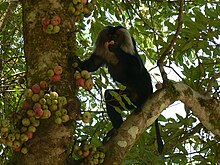Ficus racemosa: Difference between revisions
| Line 66: | Line 66: | ||
[[File:LTM_ficus.JPG|Lion-tailed macaque feeding in this ficus|thumb|left]] |
[[File:LTM_ficus.JPG|Lion-tailed macaque feeding in this ficus|thumb|left]] |
||
Health Uses |
'''Health Uses''' |
||
The bark of Audumbar/Oudumbar tree is said to have healing power. |
The bark of Audumbar/Oudumbar tree is said to have healing power. |
||
In countries like India, the bark is rubbed on a stone with water to make a paste and the paste is applied over the skin which is having boils or dryness. |
In countries like India, the bark is rubbed on a stone with water to make a paste and the paste is applied over the skin which is having boils or dryness. |
||
Revision as of 18:35, 28 January 2012
| Ficus racemosa | |
|---|---|

| |
| Scientific classification | |
| Kingdom: | |
| (unranked): | |
| (unranked): | |
| (unranked): | |
| Order: | |
| Family: | |
| Genus: | |
| Species: | F. racemosa
|
| Binomial name | |
| Ficus racemosa | |
| Synonyms | |
|
Ficus glomerata Roxb. | |
Ficus racemosa (syn. Ficus glomerata Roxb.) is a species of plant in the Moraceae family. Popularly known as the Cluster Fig Tree or Goolar (Gular) Fig, this is native to Australasia, South-East Asia and the Indian Subcontinent. it is unusual in that its figs grow on or close to the tree trunk.In India the tree and its fruit are called gular in the north and atti in the south.The fruits are a favorite staple of the common Indian macaque. In Vietnam, it is called sung.
It serves as a food plant for the caterpillars of the butterfly the Two-brand Crow (Euploea sylvester) of northern Australia.[1]
In Hinduism
In the Atharva Veda, this fig tree (Sanskrit: uḍumbara or udumbara)[2] is given prominence as a means for acquiring prosperity and vanquishing foes.[3] For instance, regarding an amulet of the udumbara tree, a hymn (AV xix,31) extols:
- The Lord of amulets art thou, most mighty: in thee wealth's
- ruler hath engendered riches,
- These gains are lodged in thee, and all great treasures. Amulet,
- conquer thou: far from us banish malignity and indigence,
- and hunger.
- Vigour art thou, in me do thou plant vigour: riches art thou, so
- do thou grant me riches.
- Plenty art thou, so prosper me with plenty: House-holder, hear
- a householder's petition.[4]
It has been described in the story of Raja Harischandra of the Ikshvaku dynasty, that the crown was a branch of this Udumbura tree, set in a circlet of gold. Additionally, the Throne (simhasana) was constructed out of this wood and the royal personage would ascend it on his knee, chanting to the gods to ascend it with him, which they did so, albeit unseen.
In Buddhism

Both the tree and the flower are referred to as the udumbara (Sanskrit, Pali; Devanagari: उडुम्बर) in Buddhism.[5] Udumbara can also refer to the blue lotus (Nila udumbara) flower. The udumbara flower appears in chapters 2 and 27 of the Lotus Sutra, an important Mahayana Buddhist text. The Japanese word udonge (優曇華) was used by Dōgen Zenji to refer to the flower of the udumbara tree in chapter 68 of the Shōbōgenzō ("Treasury of the Eye of the True Dharma"). Dōgen places the context of the udonge flower in the Flower Sermon given by Gautama Buddha on Vulture Peak. Udonge is also used to refer to the eggs of the lacewing insect. The eggs are laid in a pattern similar to a flower, and its shape is used for divination in Asian fortune telling.[6]
Uses

In historical times both Hindu and Buddhist ascetics on their way to Taxila, (Original name is Taksha Sila) travelling through vast areas of Indian forests used to consume the fruit during their travels. One challenge to vegetarians were the many fig wasps that one finds when opening a gular fig. One way to get rid of them was to break the figs into halves or quarters, discard most of the seeds and then place the figs into the midday sun for an hour. Gular fruit are almost never sold commercially because of this problem[citation needed].

Health Uses The bark of Audumbar/Oudumbar tree is said to have healing power. In countries like India, the bark is rubbed on a stone with water to make a paste and the paste is applied over the skin which is having boils or dryness.
International naming
- மலையின் முனிவன் (Malaiyin munivan) in Tamil
- அத்தி (atti) in Tamil and Malayalam.
- उंबर (Umbar) / औदुंबर (Oudumbar) in Marathi.
References
- ^ Braby, Michael F. (2005). The Complete Field Guide to Butterflies of Australia. Collingwood, Victoria: CSIRO Publishing. p. 194. ISBN 0-643-09027-4.
- ^ Monier-Williams, Monier (1899, 1964). A Sanskrit-English Dictionary (London: Oxford University Press), pp. 175, 186. Retrieved 19 Nov 2008 from "Cologne University" at http://www.sanskrit-lexicon.uni-koeln.de/scans/MWScan/MWScanpdf/mw0175-ujjha.pdf and http://www.sanskrit-lexicon.uni-koeln.de/scans/MWScan/MWScanpdf/mw0186-udaya.pdf.
- ^ See, e.g., Shyam Singh Shashi (1999), Encyclopaedia Indica (Anmol Publications), Ch. 9 "The Tree Cult," esp. pp. 241, 244-46. Retrieved 19 Nov 2008 from "Google Books" at http://books.google.com/books?id=jMmYDrm_7NAC&pg=PA245&lpg=PA245&dq=%22Atharva+Veda%22+%2Budumbara&source=bl&ots=fFDRDDKwjG&sig=Cz2M4dHwRFAE7Kq5EvltRO2sbV0&hl=en&sa=X&oi=book_result&resnum=3&ct=result#PPA247,M1.
- ^ Ralph T.H. Griffith (trans.) (1895-6). Hymns of the Atharva Veda, pp. 236-7. Retrieved 19 Nov 2008 from "Sacred Texts" at http://www.sacred-texts.com/hin/av/av19031.htm.
- ^ McCullough, Helen Craig (1994). Genji and Heike: Selections from The Tale of Genji and The Tale of the Heike. Stanford University Press. p. 94. ISBN 0804722587.
{{cite book}}: Unknown parameter|coauthors=ignored (|author=suggested) (help) - ^ Hadamitzky, Wolfgang (1996). The Kanji Dictionary. Tuttle Publishing. p. 783. ISBN 0804820589.
{{cite book}}: Unknown parameter|coauthors=ignored (|author=suggested) (help)
External links
- "Ficus racemosa". Australian Plant Name Index (APNI), IBIS database. Centre for Plant Biodiversity Research, Australian Government.
